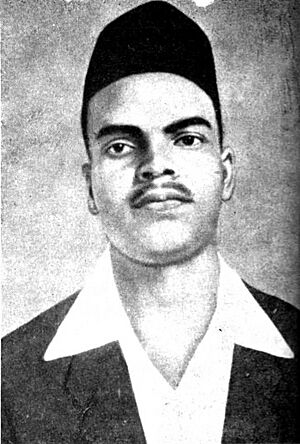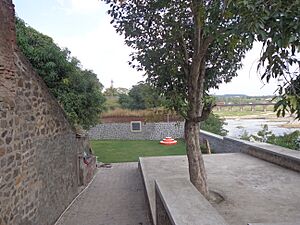Shivaram Rajguru facts for kids
Quick facts for kids
Shivaram Rajguru
|
|
|---|---|

Shivaram Hari Rajguru
|
|
| Born |
Shivaram Hari Rajguru
24 August 1908 [[Rajgurunagar (Khed) Pune |Khed]], Bombay Presidency, British India
(present-day Rajgurunagar, Maharashtra, India) |
| Died | 23 March 1931 (aged 22) |
| Cause of death | Execution by hanging |
| Nationality | Indian |
| Occupation | Independence activist |
| Organization | HSRA (Hindustan Socialist Republican Organisation) |
| Movement | Indian Independence movement |
| Criminal charge(s) | Murder of John P. Saunders and Chanan Singh |
| Criminal penalty | Capital punishment |
| Criminal status | Executed |
Shivaram Hari Rajguru (born August 24, 1908 – died March 23, 1931) was a brave freedom fighter from Maharashtra, India. He is well-known for his role in the fight for India's independence from British rule. Rajguru was a key member of the Hindustan Socialist Republican Association (HSRA). He was executed by the British government on March 23, 1931, alongside his friends Bhagat Singh and Sukhdev Thapar.
Rajguru's Early Life
Rajguru was born on August 24, 1908, in a place called Khed. His parents were Parvati Devi and Harinarayan Rajguru. Khed is located near the Bheema River in Pune.
When Rajguru was just six years old, his father passed away. His elder brother, Dinkar, then took care of the family. Rajguru went to primary school in Khed. Later, he studied at the New English High School in Pune. He joined a group called Seva Dal when he was young.
Becoming a Freedom Fighter
Rajguru was a dedicated member of the Hindustan Socialist Republican Association. This group strongly believed that India should be free from the British Raj, which was the British rule over India. They were ready to do whatever it took to achieve this freedom.
Rajguru is remembered for his bold actions as a revolutionary. One famous event he was part of was the Kakori Conspiracy in 1925. In this event, revolutionaries stopped a British train and took money from it. They used this money to fund their fight for freedom. Rajguru, along with other heroes like Ram Prasad Bismil, played a big part in this daring act.
Rajguru became close friends with Bhagat Singh and Sukhdev Thapar. Together, they took part in an important event in Lahore on December 17, 1928. This action was to get justice for Lala Lajpat Rai. He was a respected leader who was badly beaten by the police during a protest. Lala Lajpat Rai died soon after this incident.
Rajguru's Lasting Legacy
The house where Rajguru was born is called Rajguru Wada. It is a special place located by the Bhima River. This house is now kept as a memorial to honor Shivaram Rajguru. A local group, the Hutatma Rajguru Smarak Samiti, raises the Indian flag there every Republic Day.
His hometown, Khed, was renamed Rajgurunagar to honor him. Rajgurunagar is now a town in the Pune district of Maharashtra.
There is also a college named after him in Delhi. It is called Shaheed Rajguru College of Applied Sciences for Women. It is part of Delhi University.
See also
- Ashfaqulla Khan
- Kakori Train Robbery
- Thakur Roshan Singh
- Batukeshwar Dutt



